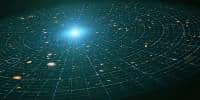There might have been more than one Great Bang. Another Big Bang that filled our universe with dark matter particles may have occurred at the same time as the emergence of all the particles and radiation in the cosmos. And perhaps we can find it.
According to conventional cosmological theory, the early universe was a very strange world. The event of inflation, which occurred very soon after the Big Bang and caused our universe to experience an era of extremely rapid expansion, was perhaps the most significant thing to occur in our universe. When inflation came to an end, the exotic quantum fields that were responsible for it decayed, transforming into the current deluge of particles and radiation.
During a process known as Big Bang nucleosynthesis, these electrons started to put themselves together to form the first protons and neutrons less than 20 minutes after the Big Bang. A cornerstone of contemporary cosmology, big bang nucleosynthesis makes precise predictions of the universe’s hydrogen and helium content.

We still don’t comprehend the dark matter, the enigmatic and invisible form of matter that makes up the vast majority of the universe’s mass, despite the success of our model of the early universe. In Big Bang theories, it is generally accepted that the same process that produced electrons and radiation also produced dark matter. The dark matter then continued to linger, oblivious to everyone else.
However, a group of experts has put forth a novel concept. They contend that the Big Bang and inflationary periods were not unique. It’s possible that the evolution of dark matter took a totally different path. In this scenario, even after inflation stopped, the cosmos was still flooded with radiation and particles. Dark matter, however, is not. Instead, a portion of the quantum field persisted and did not vanish. That extra quantum field ultimately underwent a transformation that led to the formation of dark matter as the universe cooled and expanded.
This method has the benefit of separating the evolution of dark matter from that of ordinary matter, allowing us to continue thinking about the Big Bang’s nucleosynthesis while dark matter develops in a different direction.
This method also makes it possible to investigate a wide range of theoretical models of dark matter because it is now simpler to keep track of in calculations to see how it might compare to observations because it has a distinct evolutionary track. For instance, the authors of the article were able to conclude that the so-called dark Big Bang had to have occurred when our universe was only a few days old.
The study also discovered that the emergence of a dark Big Bang released a remarkably distinct signature of potent gravitational waves that would endure into the modern cosmos. If these gravitational waves exist, they should be detectable by ongoing studies like pulsar timing arrays.
Although this work provides a clear route to testing the theory, we do not yet know whether a dark Big Bang occurred. On the arXiv preprint server, the research is made public.















